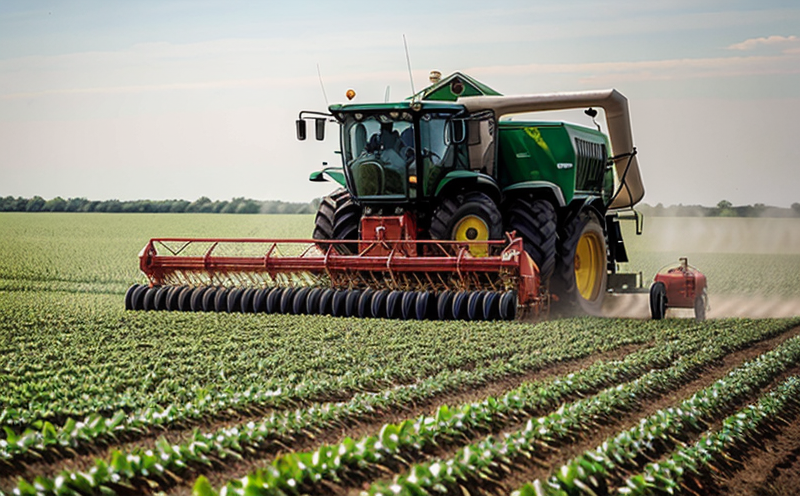Plant Height Measurement Testing
In the realm of agriculture and forestry testing, plant height measurement plays a pivotal role in evaluating crop yield and productivity. This service is essential for ensuring that crops reach their full potential during the growing season. By accurately measuring plant heights at various developmental stages, agricultural scientists can gain critical insights into the health and growth patterns of plants, which directly impacts overall yield.
The process involves meticulous specimen preparation and precise measurement techniques using specialized equipment such as laser scanners, digital calipers, or manual rulers. These tools help in capturing accurate height data that is crucial for making informed decisions about irrigation schedules, nutrient application rates, and pest management strategies. The collected data is then analyzed to identify trends and correlations with environmental factors like soil type, water availability, and climate conditions.
The importance of this service extends beyond just individual farm operations; it has broader implications for agricultural research and development (R&D). By standardizing measurement protocols according to international standards such as ISO 21089, researchers can ensure consistency across different regions and institutions. This standardization allows for the comparison of results from various studies conducted worldwide, facilitating knowledge sharing and innovation within the sector.
For quality managers responsible for ensuring product consistency and compliance officers tasked with adhering to regulatory requirements, accurate plant height measurements are indispensable tools in their arsenal. They enable these professionals to monitor crop development closely, adjust farming practices accordingly, and maintain high standards of agricultural production. Additionally, R&D engineers rely heavily on this service when developing new varieties or hybrid combinations aimed at improving resistance against diseases or enhancing nutritional value.
Incorporating plant height measurement into procurement processes ensures that only healthy specimens are selected for breeding programs or commercial distribution. This practice not only enhances the economic viability of agricultural enterprises but also contributes positively to environmental sustainability by reducing waste and promoting efficient resource utilization throughout supply chains.
Why It Matters
The accuracy of plant height measurements is crucial because it influences multiple aspects of crop management, including water usage efficiency, fertilizer application timing, and harvesting schedules. Inefficient measurement practices could lead to overwatering or under-fertilizing crops, resulting in suboptimal yields and increased costs for farmers.
Moreover, consistent monitoring allows early detection of potential issues such as nutrient deficiencies or pest infestations by comparing actual measurements against expected growth rates based on historical data. Early intervention measures can prevent these problems from escalating into larger-scale threats that might affect entire harvests.
From a broader perspective, accurate plant height measurements contribute to sustainable agricultural practices by optimizing resource allocation and minimizing environmental impact. By reducing unnecessary inputs while ensuring optimal conditions for plants' growth, this service supports the transition towards more eco-friendly farming methods.
Benefits
The implementation of rigorous plant height measurement protocols offers numerous benefits to stakeholders across the agricultural sector:
- Enhanced Yield Potential: Accurate measurements provide valuable information about how plants are responding to different treatments, allowing for adjustments that maximize yield.
- Improved Resource Efficiency: By correlating plant heights with resource utilization, farmers can adopt strategies that minimize water and nutrient waste.
- Early Disease Detection: Monitoring plant growth consistently helps identify signs of stress or infection at an early stage when treatments are more effective.
- Regulatory Compliance: Adherence to international standards ensures that all activities meet necessary legal requirements, protecting both producers and consumers alike.
- Data-Driven Decision Making: Reliable data on plant heights supports evidence-based decision-making processes throughout the entire production cycle.
- Increased Profitability: Optimizing resources and preventing losses due to disease or poor growth contribute significantly to increased profitability for agricultural enterprises.
These benefits underscore why precise plant height measurement is not just a technical requirement but also an essential component of modern agriculture aimed at achieving sustainability goals while enhancing productivity.
Competitive Advantage and Market Impact
In today's competitive market, agricultural businesses that invest in advanced plant height measurement technologies gain significant advantages over their competitors. These enterprises can offer higher quality products backed by scientific validation, which attracts discerning customers seeking reliability and safety.
By leveraging accurate data from plant height measurements, companies can develop innovative solutions tailored specifically to meet specific regional needs or climate conditions. This capability enables them to stay ahead of market trends and adapt quickly to changing consumer preferences.
The ability to accurately measure plant heights also facilitates better communication between suppliers, buyers, and end-users along the supply chain. Clearer information about crop quality fosters trust among all parties involved, leading to stronger relationships and potentially higher sales volumes.
From an environmental standpoint, adopting best practices in plant height measurement contributes positively towards reducing carbon footprints associated with agricultural activities. Efficient resource use reduces emissions from transportation and processing operations while promoting healthier ecosystems through sustainable farming practices.





